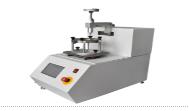Crosshatch Scratch Tester:
The Crosshatch Scratch Tester is a specialized instrument designed to assess the adhesion strength of coatings, paints, and films on various substrates. By creating a precise grid of incisions and evaluating material resistance to peeling or flaking, this device plays a pivotal role in quality control across industries such as automotive, aerospace, and consumer electronics. This article explores its functionality, applications, and technological advancements.
How It Works
The tester operates by using a cutting tool to create a crosshatch pattern (typically 1mm or 2mm spacing) on the coated surface. Key features include:
- Adjustable Parameters: Cutting speed, depth, and angle (commonly 30°–60°) to simulate real-world wear.
- Adhesive Tape Test: After scoring, pressure-sensitive tape is applied and removed to quantify coating removal.
- Rating System: Results are classified per standards like ASTM D3359 (0–5 scale) or ISO 2409 (0–5 scale), where 0 indicates perfect adhesion and 5 denotes severe peeling.
Modern testers, such as the Elcometer 1620 or Sheen 925, incorporate digital micrometers and LED lighting for enhanced accuracy.

Industrial Applications
- Automotive Industry: Evaluates paint adhesion on car bodies, bumpers, and interior trims to ensure durability against environmental stress.
- Aerospace Sector: Tests coatings on aircraft components for resistance to extreme temperatures and UV exposure.
- Consumer Electronics: Assesses screen protectors, phone casings, and wearable devices for scratch and peel resistance.
- Medical Devices: Validates biocompatibility of coatings on implants and surgical instruments.
Market Trends and Innovations
As industries prioritize lightweight and sustainable materials, the Crosshatch Scratch Tester has evolved to meet new challenges:
- Automation: Robotic arms and AI-driven image analysis (e.g., BYK-Gardner’s Auto-Scratch) reduce human error and speed up testing.
- Eco-Friendly Adhesives: Testing protocols now accommodate water-based and bio-derived coatings, aligning with global sustainability goals.
- Portable Solutions: Compact models like the TQC SP1200 enable on-site quality checks, critical for construction and field repairs.
Leading manufacturers, including Erichsen and Defelsko, are integrating IoT connectivity for real-time data sharing and predictive maintenance, further enhancing the tester’s value in smart factories.
In conclusion, the Crosshatch Scratch Tester remains an essential tool for ensuring coating integrity. By embracing automation and sustainability, it continues to drive innovation across industries, making it a key focus for businesses seeking to optimize product performance and regulatory compliance.

